Updated 04 Jan 2014
|
Flooding on Dorset Stour - Averages
|
|
Flooding on Dorset Stour - Averages.
|
This page shows monthly and yearly average RAINFALL and WATERTABLE
for Bear Mead.
Also an estimated
RIVER FLOW RATE for a range of river heights,
MASS TRANSPORT caused by rain, and
pH readings.
Location of Bear Mead:
2,100 metres upstream of Julians Bridge, Wimborne Minster, Dorset, UK.
and 1,090 metres upstream of Eyebridge.
|
Have a look at the following: |
|
|
|
|
Note:
The 2 month delay between rainfall and watertable maxima.
Flood season covers Nov-Mar
6 of 11 floods occured Nov 26-Dec 15.
The high July watertable average, caused by a very wet '07 and '08
|
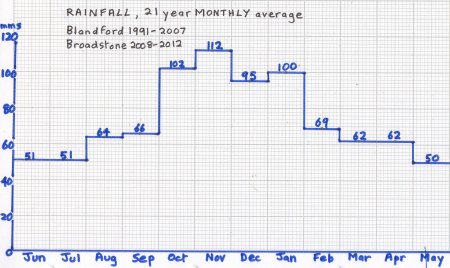 |
Rainfall in Dorset (mms per month)
2000 2001 2002 2003 2004 2005 2006 2007 2008 2009 2010 2011 2012 2013 2014 Av
Jan 44 108 98 124 128 55 26 161 133 99 72 106 47 120 98
Feb 94 83 111 41 50 18 59 105 49 92 89 84 21 48 66
Mar 46 146 56 43 51 47 77 75 102 26 80 18 33 100 62
Apr 152 88 54 52 80 69 24 4 76 51 34 4 139 58 65
May 64 22 107 44 37 31 101 111 91 25 13 32 65 54 51
Jun 21 21 35 47 44 33 24 109 51 68 38 98 160 25 55
Jul 54 64 49 50 45 60 40 132 82 80 28 33 132 32 53
Aug 41 23 36 14 86 59 52 86 119 52 109 123 67 28 63
Sep 111 59 49 5 50 26 45 32 75 23 24 58 92 42 66
Oct 173 168 167 82 177 129 145 36 100 92 37 58 169 141 107
Nov 167 44 220 125 25 81 153 115 82 196 110 49 151 61 111
Dec 164 26 139 74 61 89 84 96 22 150 61 92 176 213 104
Tot 1131 852 1121 701 834 697 830 1062 982 954 695 755 1252 922 902
(Data derived from that supplied by Environmental Agency for Rivers House,
Blandford, 1991-2007, for 2008-2013 on from Author's measurements at Broadstone)
|
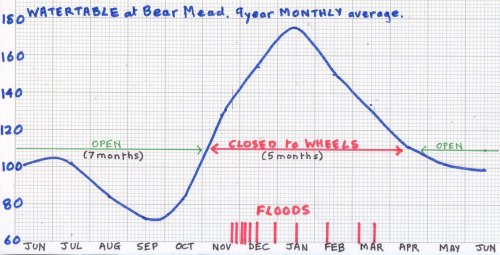
Watertable at Bear Mead, Dorset
Average cms above datum
'03 '04 '05 '06 '07 '08 '09 '10 '11 '12 Average
Jan - 172 129 114 202 185 159 184 178 165
Feb - 140 110 116 179 163 181 164 144 150
Mar - 133 86 114 164 152 145 174 107 134
Apr - 134 100 107 108 123 92 146 81 111
May - 115 89 104 117 133 96 91 70 102
Jun - 93 92 107 116 143 97 77 65 99
Jul - 95 84 97 162 150 95 70 62 102
Aug 55 82 71 72 119 107 104 69 73 84
Sep 49 77 51 59 88 102 72 73 80 72
Oct 48 130 65 86 81 108 68 90 68 83
Nov 104 121 123 142 114 181 176 120 74 128
Dec 158 125 144 194 175 158 211 113 110 154
(Data measured by author at Bear Mead)
|
River Flow rate at Bear Mead |
Water speed measured by timing an orange to travel the drift line
(about 167 metres). (This method does not work in summer with river <200
because of weed).
Drift length and river width measured using Google Earth.
Depth measured using a kayaker with a pole with scale to sound the river
in several places.
Centre of picture is at O.S. ref: SY 989-994
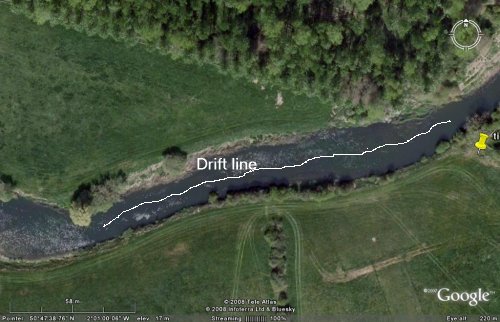
North shore 164.64 metres,
Centre line 167.08,
South shore 170.76,
Average width 21.62,
Average depth 2.70 at River=290
(measured by Warren in a red kayak)
Volume 167.08 x 21.62 x 2.70= 9,753 cu metres
for river=290.
Floods when river height=350 when flow rate=80 cu m/sec=80 tonnes/sec
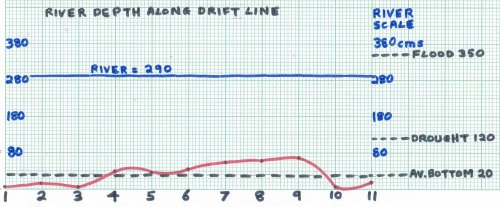
|
River Flow readings |
Estimated Flow rate in cubic metres/second for different
river heights.
Flow rate=[167.08x21.62x (height-0.2)]/time.
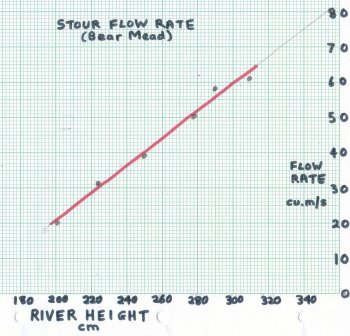
River Drift Water Flow
Date Height Time Speed Rate
2008 cms secs m/sec cu m/sec
4 Jun 290 180 0.93 58
5 Jun 224 260 0.64 31
6 Jun 201 360 0.46 20
10 Jul 278 202 0.83 50
11 Jul 310 180 0.93 62
12 Jul 250 240 0.70 38
13 Jul 213 316 0.53 24
2012
13 Oct 347 200 1.39 98
|
|
On 4-5-6 February 2008, 32 mms of rain fell on the 1,300 sq km Stour
catchment area in 48 hours, a total of 42 million tonnes.
About 20% became surface runoff, causing an increase in the river flow
rate (highlighted), estimated at transporting an extra 8.4 million
tonnes in 6 days. A peak of 3.4 million tonnes was reached on the third
day after the rain.
About 80% soaked into the ground, causing the groundwater level to rise
by an average of 2.56 cms. This stored rainwater would return to the river
by seepage over a period of months or years, or be reduced by evaporation
or transpiration during the remaining summer.
In the floodplains, the groundwater rose by 55 cms before seepage
caused it to return to its previous value in about 7 days.
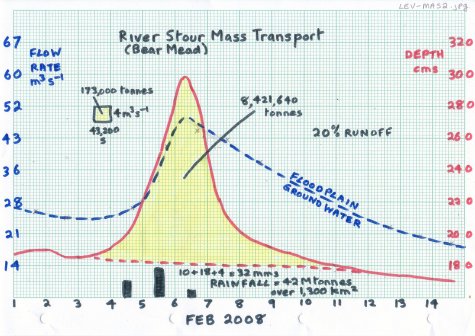 |
On 9th and 10th July 2008, 47 mms of rain fell on the 1,300 sq km Stour
catchment area in 24 hours, a total of 61 million tonnes.
About 17% became surface runoff, causing an increase in the river flow
rate (highlighted), estimated at transporting an extra 10 million
tonnes in 5 days. A peak of 4 million tonnes was reached on the second
day after the rain.
About 83% soaked into the ground, causing the groundwater level to rise
by an average of 3.9 cms. This stored rainwater would return to the river
by seepage over a period of months or years, or be reduced by evaporation
or transpiration during the remaining summer.
In the floodplains, the groundwater rose by 80 cms before seepage
caused it to return to its previous value in about 7 days.
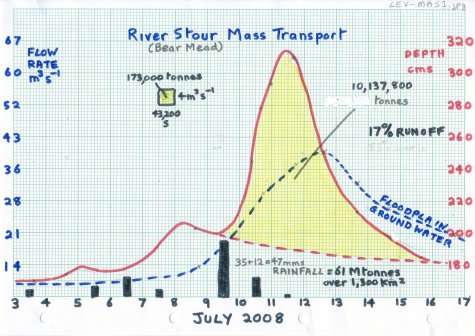 |
Comments on pH
Pure, distilled water has a pH value of 7.0.
Stream water usually ranges from pH 6.5 (slightly acidic) to a pH of 8.5,
an optimal range for most organisms.
Rain water by contrast is naturally acidic at about 5.6.
The pH of a stream affects the organisms living there.
The optimum for most is between 7 and 8 and aquatic insects 4-5.
Acid rain, from car exhaust or coal-fired power stations, causes a drop
in the pH of water.
Pollution from accidental spills, agricultural runoff and sewer overflows
can also change the pH.
Buffering capacity is water's ability to resist changes in pH, and is
critical to the survival of aquatic life.
Limestone soils act to neutralize acidity and often result in a more
basic pH.
While young fish and insect larvae are sensitive to a low pH (acid),
extreme values on either end of the scale can be lethal to most organisms.
The type of geology and soil that the water is flowing over affects pH, e.g.
chalk soil makes the result slightly alkaline and clay soil slightly acidic.
A river flowing through chalky soil results in the pH level being about
pH 8, very slightly alkaline pH is also affected by photosynthesis of
algae and other plants in summer.
pH declines gradually in response to higher rainfall and increased total
annual discharge.
Rivers flowing through agricultural areas carry increased sediment loads,
have elevated temperatures, pH and PO4 concentrations, and lower oxygen.
Macroinvertebrate communities vary according to land use and are most
severely impacted downstream on towns.
THE pH SCALE
Higher numbers indicate alkalis,
lower values signify acidic liquids:
13 - bleach
10 - soap
8.2 - pre-1750 oceans (average)
8.1 - current oceans (average)
7.8 - oceans in 2100 (projected average)
7 - pure water
3 - vinegar
0 - battery acid
(Source: NMEA)
|
Response time of sources to rain is: River 33 hours,
Well 10 hours, Millstream 3 hours, and Scrape 0 hours
pH Readings
Rain Date Buffer River Outflow Well MStream Scrape Tapwater Rainwater
0 17 Jun - - - - - - 7.13 -
0 18 Jun - 8.29 - 7.84 - - - -
2 19 Jun - - - - - - - -
1 20 Jun 6.87 8.29 - 8.12 8.52 - - -
7 21 Jun - - - - - - - 5.35
0 22 Jun 6.88 8.26 - 8.35 7.88 7.34 - -
0 23 Jun 6.88 8.41 8.43 8.09 7.83 7.24 - -
0 26 Jun 6.85 8.59 8.50 8.29 8.31 7.15 - -
4 03 Aug 6.87 8.21 - 7.51 7.04 7.18 - 5.34
|
|
Level Calibration near Flood
|
Main
12 Nov 2008
1250 hrs
Lev=344
0

Min=110
|
Repeater
12 Nov 2008
1250 hrs
Lev=338
-6

Min=
|
Mill Stream
12 Nov 2008
1300 hrs
Lev=332
-12
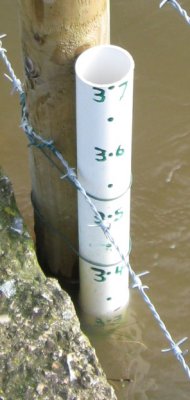
Min=245
|
Eyebridge
12 Nov 2008
1322 hrs
Lev=342
-2
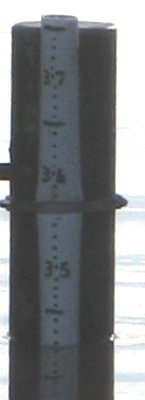
Min=275
|
Pamphill Green viewpoint, 12 Nov 2008, 1325 hrs, Lev=344, 30% flooded

|
Compiled, formatted, hyperlinked, encoded,
and copyright © 2008, John Palmer,
 All Rights Reserved. All Rights Reserved.
|












 All Rights Reserved.
All Rights Reserved.